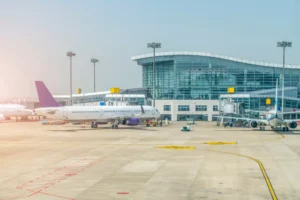What is an FTA?
A Free Trade Agreement (FTA) is an agreement between two or more countries (“partner
countries”) to facilitate trade and eliminate trade barriers. It typically removes or significantly
reduces impediments to the flow of goods and services between the partner countries. For this
purpose, modern FTAs go beyond the mere reduction of tariffs for traded goods, and address
various regulatory principles. Generally, FTAs help create an open and competitive
international marketplace.
Background to the Kenya – USA FTA
On 6th February 2020, the U.S. and the Republic of Kenya announced the launch of
negotiations to conclude a comprehensive and reciprocal FTA that would be the first of its
kind between the U.S. and a sub-Saharan African country. If successful, the negotiations
would be seen to represent the most significant innovation in U.S.-African trade relations
since the enactment of the African Growth and Opportunity Act (AGOA) trade preference
program in the U.S. in the year 2000.
By adopting a reciprocal approach toward market access and other trade issues, the
negotiation of a bilateral FTA between the U.S. and Kenya will have important ramifications
for unilateral programs like AGOA. AGOA was in fact intended to be a stepping-stone to a
more mature trade relationship between the U.S. and African countries when it was
developed over 20 years ago. AGOA is set to expire in 2025.
The proposed bilateral trade agreement also coincides with the launch, by members of the
African Union, of efforts to implement the African Continental Free Trade Area (AfCFTA),
following its enforcement on May 30, 2019. AfCFTA was signed by 44 of the 55 African
countries in Kigali, Rwanda on 21st March 2018, at the 10th Extraordinary Summit of the
African Union.
Negotiation principles
The Kenyan Ministry of Industrialization, Trade and Enterprise Development, having
consulted and heard from various stakeholders, developed and published Negotiating
Objectives and Principles to guide the negotiations of the FTA.
The principles include ensuring that the FTA is compatible to the WTO principles and allows
for application of the ‘Special and Differential Treatment’. They also include ensuring that it
is an instrument for economic and trade development, and that it respects the commitments
that Kenya has taken at multilateral (WTO), continental (AfCFTA), regional (EAC, COMESA,
TFTA) and bilateral levels. Further, they include allowing any EAC partner state that did not
participate in the negotiations to join the negotiations, subject to terms and conditions already
agreed or accede to the concluded FTA.
Negotiating Objectives
The specific objectives of the FTA include ensuring that there is no disruption of Kenya’s
market access into the USA after AGOA expires, and securing a predictable trade regime with
the U.S. that is AGOA Plus. They also include enhancing and diversifying exports of goods
and services into the U.S. under predictable and preferential terms, and stimulating industrial,
agricultural and service industry development through targeted production of goods and
services that are aligned to market opportunities in the U.S.
The FTA will also support development of value chains, especially in production and value
addition, and creation of demonstrable economic benefits to the Kenyan economy especially
creation of decent jobs and sustainable livelihoods. Further, it will strengthen and promote
Kenya’s regional, continental and global market access through revamped production and
supply capacity arising from U.S. investments triggered by the FTA.
Scope of the FTA
The FTA will cover the following areas:
1. Goods Market Access
The FTA will aim at progressively eliminating tariff and non-tariff barriers on substantially
all trade in goods in order to establish a free trade area among the parties. The scheduling of
tariff commitments will seek to maximize the benefits of regional economic integration, and
priority will be attached to early tariff elimination on products of interest to Kenya.
2. Technical Barriers to Trade (TBT)
The FTA will ensure unconditional national treatment of conformity assessment bodies and
encourage the use of international conformity assessment systems, including mutual
recognition arrangements.
3. Customs Procedures, Rules of Origin and Trade Remedies
The FTA will develop simple and easy to implement rules of origin which ensure that the
benefits of the Agreement go to products genuinely made in Kenya, building on AGOA Rules
of Origin. The rules are also intended to encourage regional value chain by allowing
cumulation across the existing regional blocs; and incentivising development of the nascent
agricultural and industrial sector in Kenya.
4. Services, Digital Trade, and Investment
The FTA will support Kenya in strengthening e-commerce and digital platforms for trade in
goods and services. It will also provide a framework to strengthen the Kenyan innovation and
entrepreneurship ecosystem, including the upgrading of innovation start-ups.
5. Intellectual Property (IP)
The FTA shall aim to reduce IP-related barriers to trade and investment by promoting
economic integration and cooperation in the utilisation, protection and enforcement of
intellectual property rights.
6. Economic and Technical Cooperation
Economic development and technical cooperation under the FTA will aim at enhancing
development in various value chains of export interest to Kenya, and maximising benefits
from its implementation.
7. State Owned and Controlled Enterprises (SOEs)
The FTA will recognise the importance of SOEs in the development of the Kenyan economy.
Consequently, it will ensure asymmetry, especially for strategic SOEs where Kenya will need
to be granted the flexibility required in shielding such SOEs from the FTA commitments.
8. Environment
The FTA will recognise the importance of the environment and support the Multilateral
Environmental Agreements (MEAs) that each country is party to, in which fora they will
continue working closely.
9. Government Procurement
The negotiations are aimed at ensuring cooperation and exchange of information on
enhancing capacity and transparency of government procurement. They will also ensure
Kenya’s participation in the USA government procurement process and the application of the
principle of asymmetry geared towards non reciprocity in government procurement.
The FTA will also cover food and agriculture, Sanitary & Phytosanitary (SPS) measures, textile
and apparel, labour, and transparency and legal issues, including the ratification of any
treaties which may have an impact on the agreement, and anti-corruption provisions.
Criticism
While Kenya has maintained that the unilateral pursuit of an FTA will bring predictability in
trading with the U.S., and that it serves as a model for other sub-Saharan Africa countries,
concerns have been raised that opening the Kenyan market to U.S. goods will kill local sectors
like agriculture and manufacturing. The FTA has also been criticised as part of Kenya’s
tendency to undermine the East Africa Community, of which Kenya is a member and whose
treaty requires negotiating trade agreements as a bloc and not as individual member states.
Conclusion
Once finalised, it is hoped that the FTA will significantly economically benefit Kenya in the
various areas outlined above, including trade, agriculture, industry, and intellectual property.
While the conclusion of such an agreement will certainly present challenges, prior trade
practice of the U.S. suggests that substantial flexibility may be incorporated into the
agreement to account for the differing levels of development between the U.S. and Kenya.
Negotiations have currently stalled, due to the Covid -19 Pandemic, and the U.S. general
elections, which have left their fate uncertain, as the U.S. realigns its interests under the new
Biden administration.
Article by Pauline Njau
This article is intended for general knowledge only. For substantive legal advice on this,
please contact us through cgmbugua@lexgroupafrica.com or pnjau@lexgroupafrica.com








